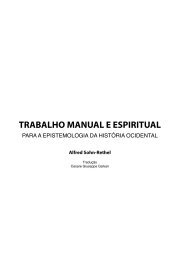Perversion the Social Relation
Perversion the Social Relation
Perversion the Social Relation
- No tags were found...
You also want an ePaper? Increase the reach of your titles
YUMPU automatically turns print PDFs into web optimized ePapers that Google loves.
"I Know Well, but All <strong>the</strong> Same ..." 89has gone through a similar period, but has forgotten it, as <strong>the</strong> fetishisttoo has. This is <strong>the</strong> period of <strong>the</strong> first Verleugnung, of <strong>the</strong> disavowalof anatomical reality, and of <strong>the</strong> constitution of <strong>the</strong> phallus as somethingmagic. I am speaking of structures, for in Talayesva's case too,of course, whatever transpired at <strong>the</strong> moment he discovered femaleanatomy, <strong>the</strong> first Verleugnung, remains obscure; <strong>the</strong> crisis of initiation,however, faithfully reproduces <strong>the</strong> same structure, as is readily seen.With Casanova, however, we have to assume <strong>the</strong> existence of a secondperiod of which <strong>the</strong> Hopi model presents not <strong>the</strong> slightest trace, a periodin which magical belief itself is attributed to <strong>the</strong> credulous, so that itis no longer by magic, but, literally, thanks to an imposture that Casanovapossesses <strong>the</strong> phallus. However, just like <strong>the</strong> shaman, this impostoris a magician all <strong>the</strong> same; magic itself survives as a "memorial to castration,"in Freud's phrase. Thus Casanova continues to be exposed to<strong>the</strong> threat of what can perfectly well be called magical castration. Theimpostor does not really have access to reality: Casanova knows well,as he says twice, that his operation will fail, but this is of no importanceto him. What is of importance to him is that <strong>the</strong> "but all <strong>the</strong> same"seems to be realized: he wants rejection of <strong>the</strong> imposture to lead back,not to <strong>the</strong> truth—which would doubtless save him, if he were capableof being saved—but to credulity. That is, he wants to be thrown backfrom his "system" to <strong>the</strong> "idea whose superstitiousness took nothingfrom its power."Constructions of this sort would only seem rash if we offered <strong>the</strong>mwith a view to reconstituting a real sequence of events, but <strong>the</strong>y are indispensableif we are to get beyond mere description and specify differencesin structure. To date, we have not had much success in treatingmagic in anything o<strong>the</strong>r than general terms; we are reduced to makingcontrastive descriptions of its most pronounced features, without beingable to say exactly how an obsessional neurotic's rituals compare andcontrast with, say, a "primitive" tribe's. When we try to chart <strong>the</strong> variouseffects of <strong>the</strong> original Verleugnung and <strong>the</strong> way in which <strong>the</strong>y aretaken up again and organized, we are led to make finer distinctions.The logical sequel to <strong>the</strong> present essay would be an attempt to discoverwhat <strong>the</strong> magic of <strong>the</strong> fetish consists of. Here, however, everythingis shrouded in darkness; <strong>the</strong> path we have followed so far does not leadto fur<strong>the</strong>r knowledge. If Verleugnung and <strong>the</strong> transformations of belief








